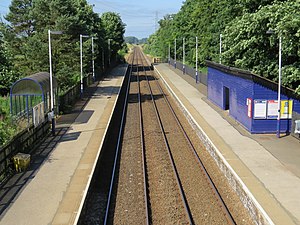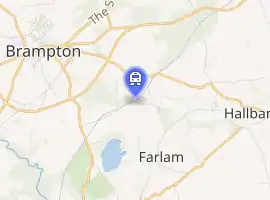Brampton railway station (Cumbria)
Brampton is a railway station on the Tyne Valley Line, which runs between Newcastle, Hexham and Carlisle. The station serves the town of Brampton in Cumbria. It is owned by Network Rail and managed by Northern Trains.
 | |
| Location | Brampton, City of Carlisle England |
| Coordinates | 54°55′57″N 2°42′11″W |
| Grid reference | NY550599 |
| Owned by | Network Rail |
| Managed by | Northern Trains |
| Platforms | 2 |
| Tracks | 2 |
| Other information | |
| Station code | BMP |
| Classification | DfT category F2 |
| History | |
| Original company | Newcastle and Carlisle Railway |
| Pre-grouping | North Eastern Railway |
| Post-grouping | |
| Key dates | |
| 20 July 1836 | Opened as Milton for Brampton |
| 1 September 1870 | Renamed Brampton |
| 1 May 1885 | Renamed Brampton Junction |
| 1 November 1891 | Renamed Brampton |
| 1 August 1913 | Renamed Brampton Junction |
| 18 March 1971 | Renamed Brampton (Cumberland) |
| 14 May 1984 | Renamed Brampton (Cumbria) |
| Passengers | |
| 2015/16 | |
| 2016/17 | |
| 2017/18 | |
| 2018/19 | |
| 2019/20 | |
| Location | |

| |
| Notes | |
Passenger statistics from the Office of Rail and Road | |
History
The Newcastle and Carlisle Railway was formed in 1829, and was opened in stages.[1] The station was opened in July 1836, following the opening of the Newcastle and Carlisle Railway between Greenhead and Carlisle London Road.[2]
Upon opening, the station was called Milton, or possibly, Milton for Brampton.[3][4] According to Quick (2019), the station has since been renamed several times.[5] Nowadays, the station is commonly suffixed as Brampton (Cumbria), in order to distinguish it from the station of the same name in Suffolk.
Brampton operated as a junction station from opening in 1836, linking with a short branch line of the Brampton Railway, known locally as The Dandy. The line, which was initially horse-drawn, ran into the town, terminating at Brampton Town.[6][7] This short branch line was taken over by the North Eastern Railway in 1912, with the track relaid and locomotive operated services resuming from August 1913, with a break from 1917 to 1920. The line was closed in October 1923, with most of the former route now serving as a public footpath.[7][8]
The station was also the junction of another railway serving the local collieries owned by the Earl of Carlisle. Known as Lord Carlisle's Railway, this ran to a junction with the Alston Line at Lambley. This mineral railway closed in March 1953.[9]
The first Station Master at Brampton was Thomas Edmondson, who introduced cardboard tickets and later developed the ticket dating machine.[10]
The station was host to a camping coach from 1935 to 1939 – one of 119 vehicles converted by the London and North Eastern Railway between 1933 and 1938.[11][12]
Brampton was reduced to an unstaffed halt in 1967, along with most of the other stations on the line that escaped the Beeching Axe. The former station buildings were subsequently demolished in stages during the 1970s and 1980s.
Facilities
The station has two platforms, both of which have a ticket machine (which accepts card or contactless payment only), seating, waiting shelter, next train audio and visual displays and an emergency help point. There is step-free access to both platforms, however the Carlisle-bound platform is not fully accessible from the station's car park. Both platforms are also linked by a pre-grouping metal footbridge, similar to those at Haltwhistle and Wetheral. There is a small car park at the station.[13]
Brampton (Cumbria) is part of the Northern Trains penalty fare network, meaning that a valid ticket or promise to pay notice is required prior to boarding the train.[14]
Services
Route 4: Tyne Valley Line | |||||||||||||||||||||||||||||||||||||||||||||||||||||||||||||||||||||||||||||||||||||||||||||||||||||||||||||||||||||||
|---|---|---|---|---|---|---|---|---|---|---|---|---|---|---|---|---|---|---|---|---|---|---|---|---|---|---|---|---|---|---|---|---|---|---|---|---|---|---|---|---|---|---|---|---|---|---|---|---|---|---|---|---|---|---|---|---|---|---|---|---|---|---|---|---|---|---|---|---|---|---|---|---|---|---|---|---|---|---|---|---|---|---|---|---|---|---|---|---|---|---|---|---|---|---|---|---|---|---|---|---|---|---|---|---|---|---|---|---|---|---|---|---|---|---|---|---|---|---|---|
| |||||||||||||||||||||||||||||||||||||||||||||||||||||||||||||||||||||||||||||||||||||||||||||||||||||||||||||||||||||||
Following the December 2020 timetable change, there are 10 trains per day (8 on Sunday) towards Carlisle. Towards Hexham and Newcastle, there are 10 trains per day (8 on Saturday and 7 on Sunday). All services are operated by Northern Trains.[15]
Rolling stock used: Class 156 Super Sprinter and Class 158 Express Sprinter
References
- James, Leslie (November 1983). A Chronology of the Construction of Britain's Railways 1778-1855. Shepperton: Ian Allan. p. 22. ISBN 0-7110-1277-6. BE/1183.
- Joy, David (1983). The Lake Counties - (A Regional history of the railways of Great Britain). Newton Abbot: David & Charles. p. 270. ISBN 0-946537-02-X.
- Quick 2019, pp. 87 & 452.
- "Opening of the Newcastle and Carlisle Railway". Cumberland Pacquet, and Ware's Whitehaven Advertiser. 26 July 1836. p. 3. Retrieved 2 June 2020. – via britishnewspaperarchive.co.uk (subscription required)
- Quick 2019, pp. 87, 452 & 494.
- Quick 2019, p. 87.
- Hoole 1986, p. 202.
- Backtrack May 2017, p. 285.
- Hoole 1986, pp. 201-202.
- Farr 1997, p. 141.
- McRae 1997, p. 8.
- McRae 1997, p. 10.
- "Brampton (Cumbria) Station Train Tickets, Departures and Timetables". Northern Trains. Retrieved 20 October 2020.
- "Penalty Fares Map". Northern Trains. Retrieved 20 October 2020.
- "Train times: Sunderland and Newcastle to Hexham and Carlisle" (PDF). Northern Trains. 13 December 2020. Retrieved 14 December 2020.
Bibliography
- Farr, Michael G.D. (1997). "Edmondson, Thomas". In Simmons, Jack; Biddle, Gordon (eds.). The Oxford Companion to British Railway History From 1603 to the 1990s (1st ed.). Oxford: Oxford University Press. p. 141. ISBN 0-19-211697-5.
- Hoole, K. (1986). The North East. A Regional History of the Railways of Great Britain. 4 (3rd ed.). Newton Abbott: David St John Thomas. ISBN 0946537313.
- McRae, Andrew (1997). British Railway Camping Coach Holidays: The 1930s & British Railways (London Midland Region). Scenes from the Past: 30 (Part One). Foxline. ISBN 1-870119-48-7.
- Quick, Michael (2019) [2001]. Railway passenger stations in Great Britain: a chronology (PDF) (5th ed.). Railway and Canal Historical Society.
External links
 Media related to Brampton (Cumbria) railway station at Wikimedia Commons
Media related to Brampton (Cumbria) railway station at Wikimedia Commons- Train times and station information for Brampton railway station (Cumbria) from National Rail
| Preceding station | Following station | |||
|---|---|---|---|---|
| Haltwhistle | Northern Trains Tyne Valley Line |
Wetheral | ||
| Historical railways | ||||
| Naworth | North Eastern Railway Newcastle and Carlisle Railway |
How Mill | ||
| Disused railways | ||||
| Brampton Town | Lord Carlisle's Waggonway Brampton Town Branch |
Terminus | ||